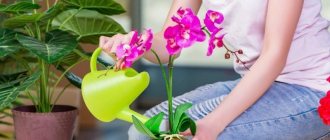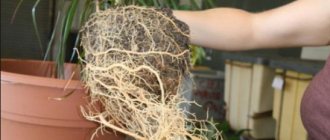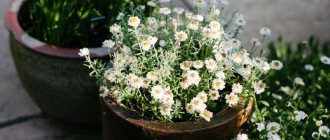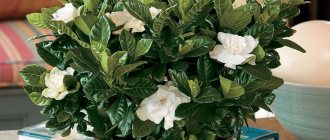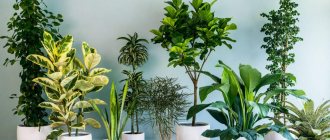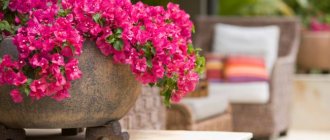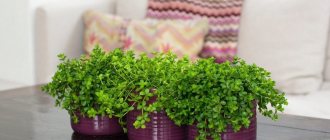Home floriculture is not only a fascinating process, but also a very troublesome hobby. Indoor plants need care, and regular care. And, as a rule, the more experience a grower has, the healthier his plants look. What should those who have no experience, but have a desire to have at home not elongated, stunted specimens, but beautiful and healthy indoor flowers that do not cause a feeling of guilt due to their fading? For beginners and flower growers who do not have much experience, I will tell you about the main mistakes in caring for indoor plants, which are easy to avoid, but the consequences of which can be very difficult to correct.
Mistakes in caring for indoor plants.
Caring for indoor plants: choosing the wrong plant
When choosing a houseplant, you need to try to find out as much as possible about it and evaluate your care capabilities, find out how suitable your room is for it? There are often people who may not water their flowers for months - they simply forgot. It would be great if they had no desire to purchase any plant. But no - they also want to decorate their interior with green pets.
Such people are categorically not recommended to buy decorative foliage and flowering plants; they cannot withstand the forgetfulness of their owners. One could recommend that they turn their attention to succulents and cacti, but the idea that they can not be watered for months is wrong. Yes, they can be watered less frequently than other plants, but they cannot be left unattended for a long time either.
A cactus near a computer monitor is a special case! Those lovers who put the poor plant in a dark corner, in the hope that it will save them from harmful radiation, hope in vain - it will not save them! A cactus is a living organism; it needs sunlight to live. Without this, he will simply die slowly.
Having decided on the choice of a specific plant, you need to evaluate the seedling:
- Leaves should be clean and healthy, without dry edges, spots or specks. Even a small spot of plaque can be a sign of disease or the presence of pests.
- The growth points of a healthy plant should be alive, and young leaves should indicate that the flower is growing.
- If the chosen plant is a tree or shrub, then it is desirable that it has enough branches - the decorative effect should not be impaired.
- Flowering plants prefer to have buds - the more of them, the longer they will bloom.
- The soil in the pot should not be too dry or green, and there should be no roots sticking out of the drainage holes.
When buying a flower in a store, it is not always possible to choose an absolutely healthy specimen. This is especially true for flowers that go on sale. Some plants look absolutely deplorable, but the price is quite affordable. You can also buy such copies, but you need to be ready to provide him with the necessary help.
For one plant, immediate resuscitation will be required, while for another it is enough to be in suitable conditions. Therefore, if you have no experience in floriculture, and no desire to study this topic in depth, then it is better to refuse such a purchase.
Features of watering a home greenhouse
Some gardeners are sincerely convinced that watering a plant on a window means throwing a mug of tap water into the pot. These wrong actions are repeated every day, winter and summer, turning into a tradition. It is not surprising that with such care, even unpretentious plants quickly die. Watering does not mean turning the soil into a swamp, and if a puddle forms in the pot, the conclusion is that too much water was poured.
To begin with, you should remember that the root system needs not only moisture, but also air, and an excess of one necessarily occurs due to a lack of the other. And where there is only dampness and no oxygen, diseases of the roots and the entire plant begin. The rules for watering are extremely simple. First of all, find out all the conditions for keeping your plants. If they are unpretentious and do not require special care, then ordinary tap water will do, even if it is not suitable for drinking. However, growing flowers usually involves an individual approach to each variety.
House plant root disease
And very often something in tap H2O may not suit the flower: composition or temperature. Therefore, in order to avoid mistakes, it is highly advisable to leave the water in some container, at least overnight, so that the temperature of the liquid rises and the chlorine evaporates. But you should not water indoor flowers with boiled water; it contains practically no salts and minerals, without which growing flowers is impossible.
Determining that indoor plants need water is not difficult. If they are moisture-loving, the soil in the pot should be constantly moistened. Run your finger over the surface of the soil; if a crust has formed or the soil turns to dust under pressure, it means the flowers have not been watered for too long. You can detect drying out of the soil earlier by placing a napkin on its surface - if it is not wet, then it’s time to take the watering can.
Moisture-loving indoor plants
If the plant requires moderate irrigation, then you need to immerse your finger in the loose soil half of the first phalanx; if you do not feel moisture, then the roots also lack water. Such soil inspection on hot days with proper care must be done every day, and in autumn, winter and early spring - every 2-3 days. It is very important to observe during the watering process how well the water is absorbed into the soil. If it lingers on the surface, forming a puddle, you need to loosen the substrate that has formed the crust, acting very carefully so as not to damage the roots.
But it also happens that moisture does not stay in the soil, but immediately begins to flow out of the drainage holes in the bottom of the pot. This means that the substrate has turned into a lump, having separated from the walls of the vessel. The ideal way to solve the problem is internal watering: the pot with the plant is lowered into a deep container to the ground level so that water penetrates inside through the drainage holes and saturates the soil. Then we lift the pot and allow the excess moisture to drain, while the soil settles. This method can be found in the video.
Plants with fleshy and small leaves do not need daily watering, unlike overgrown flowers. In addition, indoor flora needs less water in winter than in summer, and plastic pots retain moisture longer than ceramic ones.
Mistakes in caring for indoor plants: inappropriate lighting
When choosing a houseplant, you need to immediately think about where it will stand and whether there is sufficient lighting in this place. That’s why you need to find out as much as possible about the plant – is it shade-tolerant or does it need bright sunlight? Most flowering plants need sun and if your windows face north, they will not bloom there.
Sometimes you see a flower standing in a dark corner in a spacious or not so spacious hallway. To the question “how does it grow here, are there no windows?” They answer: “This is a shade-tolerant plant.” So, no shade-tolerant plant can withstand the complete absence of light for a long time.
Those with southern windows can afford to grow both light-loving and shade-tolerant plants, because even in a sunny room there is a “shady” corner. It’s a little more difficult for everyone else, but there is a great way out - to master decorative foliage plants.
Aglaonema, scindapsus, philodendron, syngonium, all kinds of ferns do without bright sunlight and are distinguished by beautiful, gracefully shaped leaves, sometimes with very original patterns. They will not amaze you with lush flowering, but they will be beautiful not at certain times, but all year round, and, as a rule, they are easier to care for.
When choosing a houseplant, you need to immediately think about where it will stand and whether there is sufficient lighting in this place.
Mistakes in caring for indoor plants: incorrect temperature conditions
Most indoor plants easily adapt to normal indoor conditions, but if the room temperature is higher or lower than acceptable limits, then this problem will have to be solved. And here it is also necessary to know what a particular flower needs and under what conditions it grows in nature.
If the air temperature in the room is below normal, the plant's leaves may curl, turn black and fall off. When the temperature is too high, the lower leaves, flowers and buds fall off, and the shoots stretch, giving the plant an untidy appearance. With sudden changes in temperature, many plants' leaves turn yellow and fall off.
Especially often, indoor plants that are not properly cared for suffer in winter, when dry hot air comes from the radiators and it is cold on the windowsill. In this case, it is necessary to insulate the pots - place wooden or foam boards under them and insulate the window sill. It is better to cover the battery with a blanket or come up with another way to protect the flowers from the hot air. If possible, it is better to move the plants to another location.
Natural and artificial lighting for house plants
In the kingdom of flora, everything is interconnected, and a lack of heat or light often causes disease or attracts insects to the roots or above-ground parts of the plant. The condition of flowers is especially affected by improper lighting, the lack or excess of which can destroy the plant. Therefore, before placing indoor flowers on the windowsill of a south-facing window, where there is the most sunlight, find as much information as possible about the selected varieties.
For example, cacti prefer a lot of ultraviolet light, and growing monstera, ficus and violet is possible in shaded areas of the room.
Growing Monstera
When growing flowers, do not rely on the common misconception about shade-loving plants - they do not exist, everyone needs light to a greater or lesser extent. Be prepared for the fact that pots with flora will have to be moved from place to place throughout the year. In spring and summer, the intensity of sunlight increases to its peak. In March and April, indoor flowers only need to be shaded on south-facing windows at midday.
In the summer season, it is better to move plants away from direct sunlight, for example, to place them on western and eastern window sills. In autumn, growing flora will be more successful on the south side, since at this time, due to frequent cloudy days, flowers lack light. In winter, we even move shade-tolerant varieties there. It should be noted that artificial lighting cannot fully replace natural lighting, but it helps in winter, when the daylight hours are much shorter than the dark ones.
It should be created in dark corners, as well as along walls, away from windows. At the same time, incandescent lamps are completely unacceptable, since they heat the air around too much. Ideally, it is better to use special phytolights, but fluorescent light bulbs are also suitable as an alternative. The height at which you need to hang the lamp above beautifully flowering plants should not exceed 30 centimeters, but for decorative leaves it can be in the range from 30 to 60 centimeters. Therefore, choose models that are adjustable in height and tilt.
Phyto-lamp for indoor flowers
Growing flowers is quite possible in diffused light, if it is bright enough. Therefore, in rooms with windows facing north, it is better to paint surfaces in light colors, increasing their reflectivity. It is imperative to monitor the cleanliness of the glass; dust settling on them significantly reduces the illumination of the space in front of the windows. You should never move flower pots immediately from light to shade and vice versa.
Just gradually change their position in the house over the course of several days so that indoor plants get used to the new conditions. Caring for flora can also be expressed in shading it using screens made of tissue paper or gauze. You can watch the video to see how to do this. With too much light, plant leaves become faded; at midday, the leaves droop and dry out over time; dark spots can often be seen. A lack of light on the leaves is reflected by cessation of growth, yellowing and drying out, the variegation of color is replaced by monotony.
Mistakes in caring for indoor plants: insufficient humidity
Many novice gardeners make a serious mistake, believing that if a plant likes high humidity, it needs to be watered more often. This misconception is the main reason for the death of many indoor plants.
Plants, especially tropical ones, need sufficient air humidity, and in our rooms, as a rule, it is below normal. Watering the soil in a pot practically does not change the air humidity, but the soil can become acidic.
In this case, the plant will stop growing, its lower leaves will begin to fall off, and its entire appearance will cause pity. Such a flower can only be saved by an urgent transplant with a complete replacement of the soil. In this case, the root system must be washed in clean water and do not forget to wash the pot itself and the drainage if it is intended to be reused.
You can increase the humidity by simply spraying from a spray bottle, but for this you need to take settled water at room temperature. Flowers with pubescent leaves - violet, cyanotis, ginura, koleria and many others, as a rule, do not like moisture on the surface of the leaf plate, so such plants cannot be sprayed.
We are also not happy about water getting on the inflorescences and some flowering plants. In this case, the pots are placed in flowerpots with water. Pebbles or decorative crushed stone are poured into the bottom of the flowerpots, on which containers with flowers are placed. The bottom of the pot should not be in water - this is important.
You can also increase the humidity in the room using a humidifier - there are many offers of such devices today, and their prices are quite affordable.
Watering the soil of a houseplant does not provide air humidity.
Rules for applying fertilizers
Here are some simple tips to help you properly feed your indoor plants:
- Follow dosages strictly. Synthetic preparations have a high concentration of chemical elements, and the small doses indicated in the instructions often raise doubts among novice gardeners. Maybe add a little more? No! More doesn't mean better. Excess is even more dangerous than deficiency.
- Stick to the feeding schedule. For most potted crops, the active fertilizing season runs from April to September.
- Apply nutrient compositions only to moist soil so as not to burn the root system.
- In the first one and a half to two months after transplantation, there is no need to feed the flowers. Fresh soil still contains enough nutrients necessary for growth and development.
- Water weakened specimens with caution, using solutions in lower concentrations.
Mistakes in caring for indoor plants: lack of rest period
A period of rest is necessary for any plant, and everyone has it, but in one flower it is clearly pronounced, while in another it is barely noticeable. At this time, plants rest from rapid growth and flowering, on which the entire reserve was spent, and accumulate strength for a new period of growing season and flowering.
As a rule, our indoor ones rest in the autumn-winter period, and here each specimen has its own requirements for resting conditions. In some, such as amaryllis or gloxinia, the entire green part dies off and the pot with the tuber is put away in a dark, cool place for the winter, while others, and these are the majority, need only a slight decrease in temperature and reduced watering.
It is necessary to water the plants at this time, but do it less often and not as abundantly as during growth. No fertilizing or fertilizer is applied during the dormant period - this is a general rule for all indoor plants.
To ensure the correct rest period for your plant, you need to know where it comes from, because the inhabitants of the tropics, subtropics, deserts and semi-deserts spend their “hibernation” differently.
In the spring, when the day begins to slowly arrive, the plants gradually wake up and emerge from the dormant period. You also need to gradually increase watering, and from March-April you can start fertilizing.
Caring for indoor plants: mistakes when replanting plants
Beginning gardeners often make one serious mistake when replanting plants. We are talking about the size of the pot. Logically reasoning: “my flower, when it grows up, will be a big plant, I’ll plant it in a big pot so that there is room for the roots,” the unlucky lover practically kills his flower.
The fact is that if the root system is small, then the plant will need some time for the roots to entwine the earthen ball. If this takes a long time, the soil in the pot may turn sour, the flower will stop growing and ultimately die.
What indoor plants are grown from seeds: (read more)
Therefore, it is important to adhere to this rule: replant young plants every spring, increasing the diameter of the pot by 1-2 cm. If the container is larger than required, then you need to add more drainage to the bottom. Not all adult plants need annual replanting; for many, it is enough to simply replace the top layer of soil with a new one.
Some flowers, such as orchids, do not like unnecessary intervention and are replanted only when necessary, when there are problems with the roots or when the plant grows out of the pot.
In order for the transplant to be successful, you need to choose the right soil. In gardening stores today there is a large assortment of all kinds of soil mixtures and you can easily choose what a particular plant needs.
Drainage must be required, and it does not matter whether it is expanded clay, crushed brick or walnut shells, the main thing is that the drainage layer should be 1/5 of the height of the container.
What else I would like to pay attention to is the drainage holes. This is very important for proper care of your indoor plant! Usually flower pots are sold with pre-made holes, but often they are too small. It should be taken into account that the plant will have to spend a year in the container, and during this time the small holes will most likely become clogged with soil and water deposits and will no longer allow water to pass through. Therefore, having bought a pot, we enlarge the holes and add, if necessary, ourselves.
Transplantation is stressful, so the transplanted plant is not fertilized for 2-3 weeks, is not exposed to drafts and is not exposed to direct rays of the sun.
Young plants need to be replanted every spring, increasing the diameter of the pot by 1-2 cm.
Rules for landscaping a children's room
By caring for their green spaces, a child prepares for adulthood and learns to care for all life on Earth.
Having studied biology at school, we all know that plants not only absorb carbon dioxide, but also oxygen. Therefore, landscaping in a children's room should be done in accordance with the age of the child and depending on the area of the room.
Rules
- Until the child is six months old, it is not recommended to place any plants in the room at all, since green pets put an additional burden on the baby’s immune system.
- In the room of a six-month-old child, you can already place the first indoor flowers. You should not grow strong-smelling ones; for example, you should not decorate your room with geraniums. At this age, kids are interested in everything, so each plant should be located in the visibility zone, but out of reach, so that the child can look at the flower, but cannot “taste it for a tooth.”
- At the age of about a year or one year and a couple of months, toddlers are already trying to take their first steps. It is clear that they will want to get to know the flowers better. Therefore, the ideal solution for landscaping a children's room at this age would be hanging flower pots. You can place flowers on shelves located on the wall.
- Ages from 2 to 5 years are characterized by increased activity. The guys are interested in everything and they belong to the “why” category. Green plants will help your baby learn about the world around him.
By caring for his green spaces, a child prepares for adulthood and learns to treat all life on Earth with care.
Parents using the example of the Uzambara violet, aspidistra. geraniums or ficus will be able to explain the process of plant development. In addition, a child can be introduced to work by learning how to care for indoor flowers.
Mistakes in caring for indoor plants: diseases and pests
Despite the fact that indoor plants usually grow indoors, they, like their outdoor counterparts, can be affected by various diseases and pests. To avoid serious problems, and ultimately to avoid losing a flower, you need to regularly inspect the leaves, flowers and soil in the pot.
Often the appearance of problems is visible to the naked eye - dots and holes on the leaves, plaque in the form of rusty spots or mold, a lethargic appearance of the plant. If they are detected, you should try to find out the cause and immediately take corrective measures. If there are other flowers near the affected plant, the patient must be urgently isolated.
Some indoor plants are affected by fungal diseases - powdery mildew, late blight, gray rot and some others. The disease manifests itself with the appearance of plaque in the form of spots on the leaves. If this problem is detected, you need to spray the plant with a fungicide. The earlier treatment is started, the greater the chance of saving the flower. If it is neglected, you have to cut off the above-ground part, or even say goodbye to the plant altogether.
In addition to fungal diseases, indoor plants are threatened by viral and bacterial diseases. They all have their own symptoms, but not all of them can be cured. Sometimes, sadly, a plant has to be removed so as not to endanger the rest.
The most likely insect pests are aphids, whiteflies, scale insects, spider mites and scale insects. Conventional insecticides are used to combat parasites, but to prevent their spread, healthy plants are also sprayed for prevention.
Most often, insects settle on the underside of the leaf, so when inspecting plants you need to examine leaves on both sides.
On a note! Don't let the problems of caring for indoor plants described above scare you! Growing indoor plants is not difficult at all if you are ready for it. The main thing is to choose a suitable flower, give it everything it needs, watch its development, cope with problems in time and... while admiring it, rejoice.
